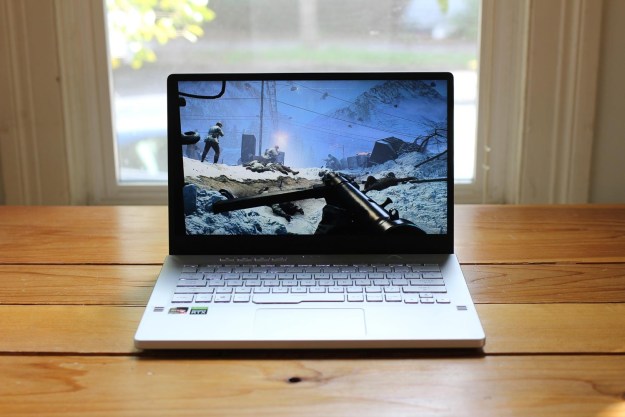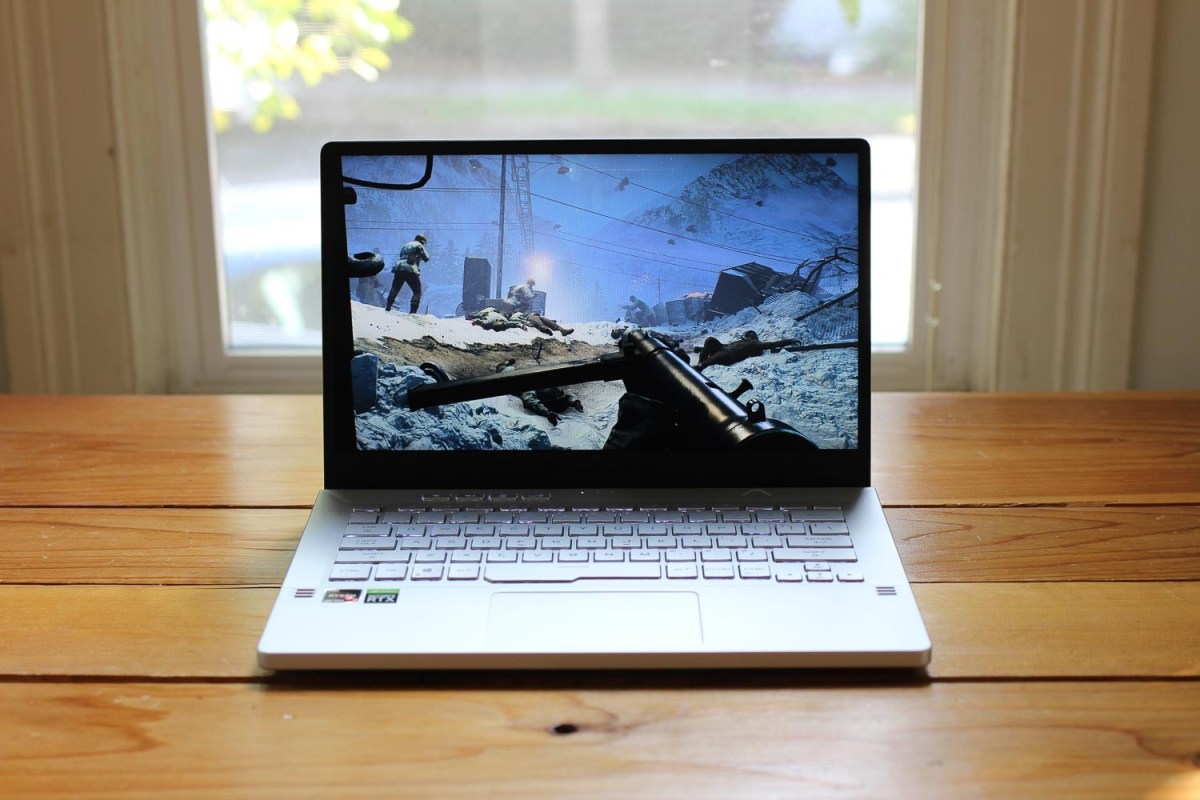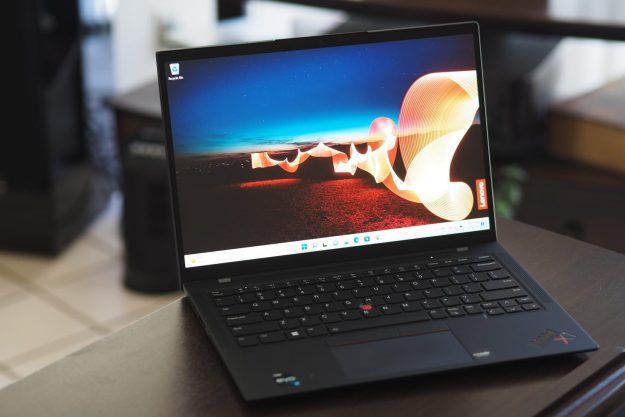
“With an eight-core processor and shockingly small chassis, the Zephyrus G14 is in a class of its own.”
- Excellent gaming machine
- Thin, small, and light
- Game-changing CPU performance
- Responsive touchpad
- Unique lid design
- Noisy at idle
- Mushy keyboard
- No webcam
The ROG Zephyrus G14 is unlike any gaming laptop you’ve ever owned. Though it packs an Nvidia RTX 2060, it weighs just 3.5 pounds. It’s not much larger than a 14-inch laptop you’d see issued at work.
How’s that possible? One very special component is at the heart of the G14: AMD’s Ryzen 9 4900HS. This eight-core, sixteen-thread chip is where the magic is.
The Zephyrus G14 has created a new class of gaming laptop, and starts at just $1,050. But is this new breed of gaming laptop what people want?
Size and portability

Asus and AMD want the G14 to be a laptop that’s just as portable as any other laptop — one you can take to school, take to work, and play games on everywhere in between.
Laptops like the Razer Blade and MSI GS65 have tried cutting out the thickness from their machines, but they’ve maintained a large screen size — 15 or 17 inches, respectively. That’s where the G14 deviates.
With a 14.0-inch display and thin bezels around the top and sides, a significant amount of girth is cut right out of the body of the laptop. That means the G14 is smaller than most gaming laptops in just about every measure, including weight. At 3.5 pounds, it’s 19% lighter than the 16-inch MacBook Pro and 24% lighter than the Razer Blade 15. The small size helps with weight, as does the magnesium alloy chassis, which is much lighter than full aluminum.

As someone who primarily uses a 13-inch laptop on a daily basis, I was shocked by the G14’s footprint when I opened the box. At just 12.8 x 8.7 inches, its footprint is around 5% smaller than a 13-inch MacBook Pro.
It’s also thin, though it’s matched by the current Razer Blade at 0.70 inches. When open, the G14 does feel thicker than it should due to the lifted hinge, which adds an extra 0.6 inches and improved airflow.
The only gaming laptop that can match the size of the Asus ROG Zephyrus G14 is Razer’s Blade Stealth, which is a 13-inch laptop with up to a GTX 1650 GPU. It’s significantly smaller, but its graphics and CPU options are much more limited as well. The Zephyrus G14 is in a class of its own.
Processor performance
The unit I tested rings up at $1,450, and sits right in the middle of the configuration stack. The Zephyrus G14 is the launch vehicle for AMD’s Ryzen 4000 chips. in particular the Ryzen 9 H-series eight-core chips meant for powerful laptops and gaming machines.
The Asus ROG Zephyrus G14 doesn’t use the standard 45-watt CPU, but instead opts for a specialized 35-watt variant known as the Ryzen 9 4900HS, along with 16GB of RAM (configurable up to 32GB). The “S” stands for slim, so it can be cooled within the small chassis of the Zephyrus G14.

Don’t worry. That doesn’t mean performance is handicapped. This Ryzen processor is insanely fast, especially if you feed it a task that can use its eight cores and 16 threads. That includes content creation, whether it’s 3D modeling or video editing.
For this kind of workload, it’s hardly worth comparing to other gaming laptops, most of which use a six-core Intel Core i7-9750H. They just can’t keep up. The eight-core Core i9-9880HK is a better competitor, though it’s mostly reserved for high-end content creation laptops like the Dell XPS 15, MacBook Pro 16-inch, or ThinkPad X1 Extreme.
For a laptop this small and light, the G14 has record-breaking performance.
But here’s the crazy thing. Whether it’s in benchmarking or real-life tests, the Asus G14 still wins over laptops with an Intel Core i9-9880HK processor. It beats the 16-inch MacBook Pro in Cinebench R20 multi-core by a whopping 25%. It even encoded a 4K file in Handbrake 11% faster, matching the performance of the Dell XPS 15.
You’ll find more power in thicker workstation-type machines with the Core i9, but for a laptop this small and light, the G14 is record-breaking.
However, there’s a reason companies don’t put expensive, sweltering Core i9s in just any old laptop. First of all, all eight cores can’t be used efficiently by most games, so that won’t do you much good. Then there’s an obvious thermal problem that Asus and AMD haven’t properly dealt with. The Zephyrus G14 is a loud little laptop. When playing games or running heavy applications, it’s distracting. But that’s forgivable.
My problem is that even at idle (and in Silent mode), the Zephyrus G14’s fans are constantly whirring. The result is an irritating coil whine that never goes away. That reduces my desire to use the G14 as a laptop I want to use every day.
Gaming performance
My Asus ROG Zephyrus G14 review unit has an Nvidia RTX 2060 for graphics, with options for the GTX 1660 Ti and GTX 1650 in cheaper configurations. The G14 is the smallest laptop to include an RTX 2060, a graphics card about as powerful as a desktop GTX 1070 video card. The result is fluid, responsive gaming in just about every title I tried.
Battlefield V, Fortnite, and Civilization VI all played at well over 60 frames per second (FPS) in 1080p at maxed-out settings. That is on par with laptops like the Dell G7 15, which is 2 pounds heavier. It beat the same RTX 2060 in the ROG Zephyrus M in every game, despite being lighter and smaller in almost every regard.

When you turn the settings down a bit, performance truly shines. Fortnite landed at 118 FPS, while Civilization VI hit 132. It’s consistently 10 FPS behind the Razer Blade, which we tested with a more powerful GPU, the RTX 2070 Max-Q.
Fast-paced shooters like Battlefield V are a great fit for the Zephyrus G14, which comes with a fast 120Hz refresh rate display. And 98 FPS on Medium and 70 at Ultra in Battlefield V are not a bad look. The G14 even makes a tough game like Assassin’s Creed: Odyssey playable, managing 64 FPS at High settings.
It can’t be overstated how big of a deal this is for AMD. The company isn’t often featured in laptops this powerful, nor in one this ambitious.
Design and display

Asus ROG Zephyrus laptops of recent years share a look. They’re black and chunky, laden with hints of RGB throughout.
The Asus ROG Zephyrus G14 stands out. The laptop made headlines at CES 2020 with its AniMe Matrix Display design on the cover, where LEDs light the laptop’s display lid with patterns and designs. You can even customize them to display text, animations, or logos of your choice.
It’s a cool feature that’ll cost you an extra $500, and my review unit didn’t include it. But even the standard white version, without the AniMe Matrix Display, is beautiful. The matrix of dots adds a splash of interest, and the white color is still unique in its own right.
That said, the G14’s design doesn’t feel cohesive. The lid is white, the keyboard deck and chassis is gray, and the bezels around the display are black. It feels like parts from a few different laptops stitched together into one device. The all-gray option fares a bit better.
The speakers could have used some more gusto.
The display is a 1,920 x 1,080 resolution IPS panel. It’s nothing special in terms of brightness of contrast, but doesn’t have any major weaknesses, either. Following the trend we’ve seen lately, it features accurate colors and a decent color gamut, showing 77% of the AdobeRGB color space.
The speakers, though, could use some more gusto. I had high hopes, as the G14 includes a pair of upward-facing tweeters and two woofers at the hinge. They’re loud enough, but a modern iPhone sounds better. Between the speakers and the coil whine, you’ll want to pair the G14 with a decent set of headphones.
Keyboard and touchpad

The inputs are a mixed bag. Let’s start with the good stuff. The touchpad is excellent, which surprised me. A touchpad in a gaming laptop this good is hard to find, since many manufacturers assume you’ll be using an external mouse. Not here. That’s a good call, since the Asus ROG Zephyrus G14 is small enough to use as an everyday laptop.
Typing on the Zephyrus isn’t a slog, but there’s room for improvement.
The keyboard is also spacious, offering the typical ROG layout, with keys like volume control inserted above the function row. Larger ROG laptops include extra keys along the right side, but they’ve been left out here. This is smart, as I’d rather have a comfortable layout than a page up and page down key.
While typing isn’t a slog, there’s definitely room for improvement. Key presses have a lot of travel, but the bottoming out action is mushy. It makes for an imprecise typing experience that grows weary over time. The keyboard backlighting is also limited. It’s a single-zone and not customizable, which is rare in a gaming laptop these days. The backlighting that is offered is uneven, lighting some keys better than others.
The power button is located above the standard layout and includes a fingerprint reader built-in. That’s important because, strangely, the Zephyrus G14 doesn’t include a built-in webcam. That means no Windows Hello facial recognition, and no Zoom calls. I get the idea — this isn’t a laptop made for video calls. Still, with its potential crossover appeal as a content creation and business laptop, it’s an odd thing to leave out.
Battery life
Gaming laptops aren’t known for battery life, even when you aren’t gaming. The Zephyrus G14 doesn’t change that, though it does last longer than other gaming laptops. The G14 managed just under 6 hours under a light web-browsing load. That doesn’t compare well to a modern ultrabook like the XPS 13 or HP Spectre x360, which can last up to 10 hours on the same test.
However, for a gaming laptop, it’s at the top of its class. It’s a half hour more than the Dell G7 Gaming Laptop and the Razer Blade, and hours ahead of laptops that have G-Sync like the Zephyrus M and Alienware M15.
On more CPU-intensive tests, the Zephyrus G14 fares even better. It lasted 4 hours in the Basemark battery test, which provides a view of battery life when running heavier applications. Add 10 hours of local video playback on one charge and you have the best battery life you can get out of a gaming laptop.
Our take
The Asus ROG Zephyrus G14 challenges other thin gaming laptops, like the Razer Blade. The G14 offers more than enough power for most PC gamers. On top of that, thanks to its eight-core processor, it’s one of the best content creation and video-editing laptops you can buy at this price.
Does it also work as a laptop in its own right? The constant hum of the fans and lack of a webcam aren’t ideal for everyday laptop usage, however, the G14’s adequate battery life and display make it a good choice for work and travel.
Are there any alternatives?
No gaming laptop is as small and powerful as the Zephyrus G14. If you go less powerful and even smaller, you can opt for something like the Razer Blade Stealth.
When you move into the world of 15-inch laptops, your options expand quickly. The Razer Blade 15 and MSI GS65 are as thin as the G14, though heavier and larger. They’re also considerably more powerful, offering graphics options up to the RTX 2080 Max-Q. The closest alternative in price is the Predator Helios 300, which offers a similar configuration, though with less processor cores and a far larger chassis.
Lastly, if you want a 15-inch laptop for content creation that can game on the side, I recommend the Dell XPS 15. It’s not as capable a gaming machine as the G14, but is a more balanced option for content creators.
How long will it last?
The G14 should last at least three or four years of gaming performance before it’ll start to show its age. It’s well-built, up-to-date, and powerful. Unfortunately, Asus only offers a one-year warranty for coverage of defects, including the battery. After that, you’re on your own.
Should you buy it?
Yes. It’s an extremely powerful laptop crammed inside a surprisingly small design.
Editors' Recommendations
- Apple could soon put an M3 chip in its worst laptop
- The best HP laptops
- The best gaming PCs for 2023: Dell, Origin, Lenovo, and more
- The best desktop computers for 2023: Dell, HP, Apple, and more
- The best tablets in 2023: top 9 picks you should buy






